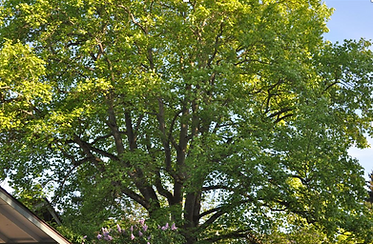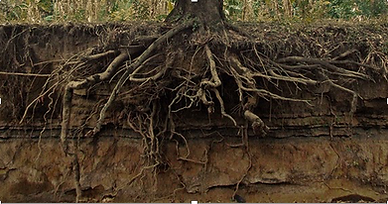
Grow Your Own Healthy Meals
Maintaining the World
By Charles Mish

Tulip tree in Seattle

Root system of a tree

Loss of farmland
Solution: Regenerative Agriculture

Loess Plateau after regeneration
Last year this beautiful tulip tree across the street from our Seattle home was playing its role in the Ray of Creation. Through the process of photosynthesis, this tree with its massive 56-foot canopy, was pulling the carbon dioxide from the air, splitting off the oxygen, converting the carbon into sugar, and leaching up to 40% of the carbon into the soil through its roots. In exchange for this sugar, microbes in the root zone were suppling minerals to the tree. Working together with the microbes, the tree was scrubbing the air of heat-trapping carbon and sequestering it in the soil. A perfect example of what might be called "reciprocal maintenance.
In addition to carbon sequestration, the tulip tree was doing an excellent job of filtering out urban pollutants and fine particulates in the city air, providing shade on hot summer days, capturing precipitation through its root system, helping to stabilize the soil on its steep bank, and reducing run off by intercepting and evapotranspiring rainfall before it became runoff.
Today the tree is gone, fallen under the axe of "Progress." In its place now stand three tall rowhouses and two townhouses. A group of concerned neighbors tried to show city officials and the developer six alternative plans that would preserve the tree and allow the developer to build his five units in a different configuration. But the developer would have none of it, and the city allowed him to bring down the tree.
Unfortunately, this an all too common story. The human multitudes are doubling, the urban tree canopy and our woods and forests are disappearing. Earth, sea, and sky are out of balance. Globally, In the last 40 years we have lost one third of our farmable land. “Poor Nature” has to" puff and blow in order to adapt Herself to remain within common cosmic harmony."
Climate change is Mother Nature’s way of letting us know that she is sick. Especially since the Industrial Revolution, we “biped destroyers of Nature’s goods” have broken the laws of world maintenance.
But there is hope for the future. Not only can climate change be mitigated by carbon reduction through clean energy, but we now have data that proves that a global transition to regenerative organic agriculture can reverse climate change.
In the inspiring film "The Lessons of the Loess Plateau," soil scientist John D. Liu documents the astounding recovery of the Loess Plateau in the ancient heartland of China. Beginning in 1995, an area the size of Belgium was transformed-- over a period of 15 years-- from a barren wasteland into a land of thriving forests, clean air and water, and fertile farmland.
Thanks to 70 years of industrial agriculture, most topsoil here in North America is in bad shape. The US loses 1.7 billion tons of topsoil to soil degradation annually, and the planet loses 30 million acres annually.
As Maria-Helena Semedo, Ph.D., of the Food and Agriculture Organization (FAO), points out, “If the current rate of land degradation continues, all of the topsoil around the world will be gone in 60 years.” That said, the steady growth of renewable energy, electric cars, and recent spike in the organic food sales in the US are steps in the right direction.
As for me personally, the question is, how do I “honorably fulfill my duty to Great Nature?”